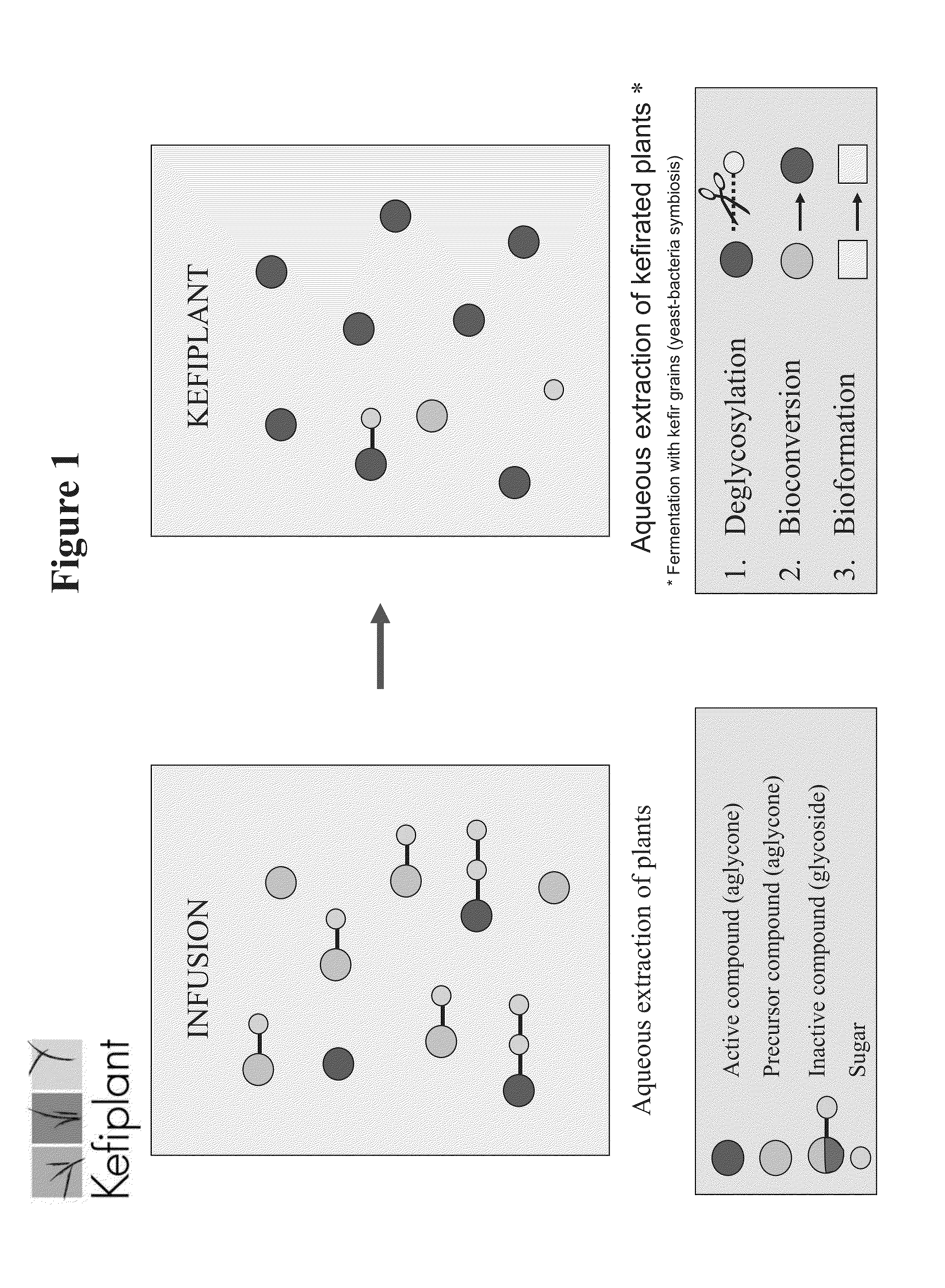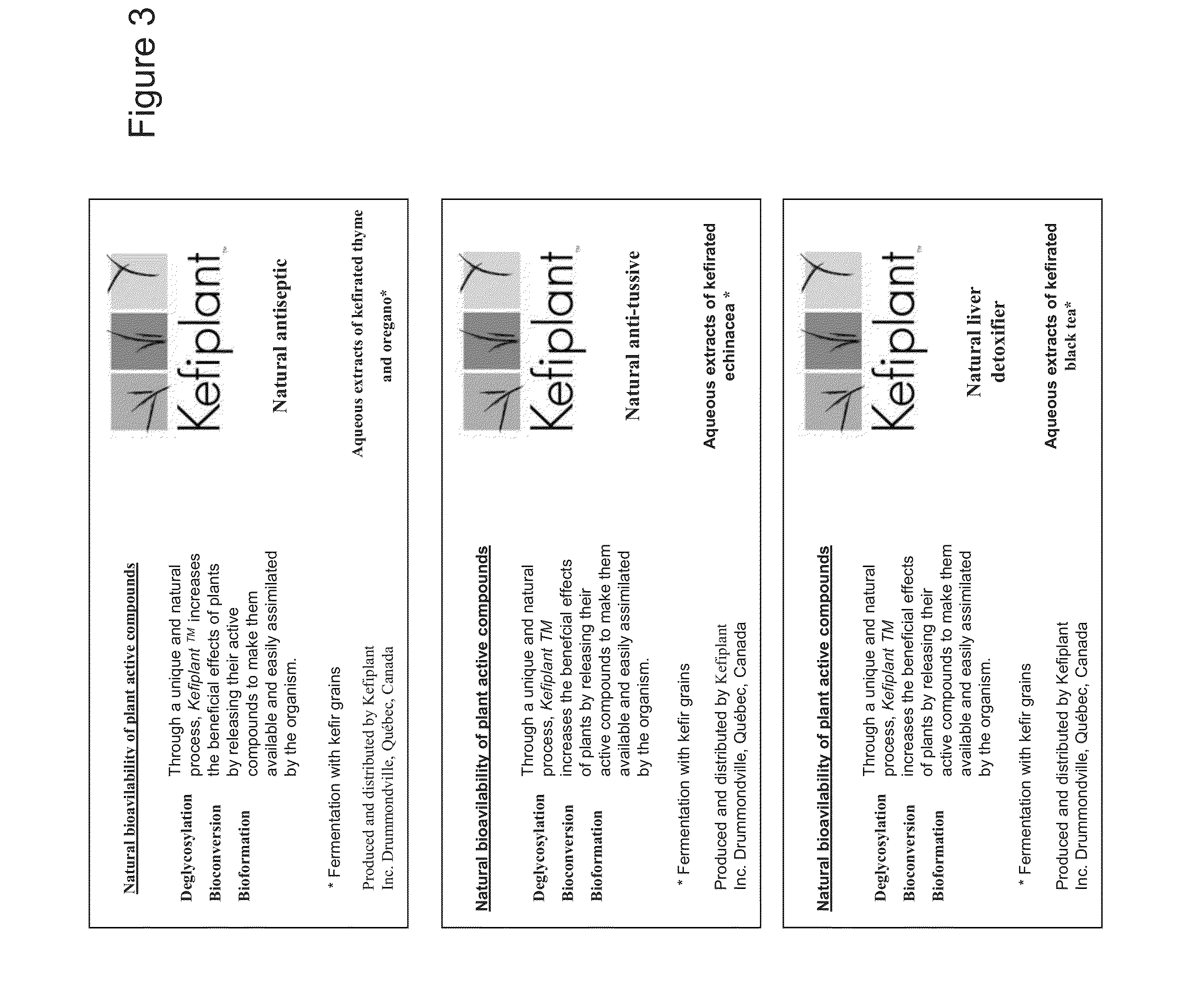Fermented plant extracts, methods of production and uses
a technology of plant extracts and fermented extracts, applied in the field of plant extracts, can solve the problems of inability to absorb glycosylated flavonoids, lack of activity, etc., and achieve the effect of increasing the amount of active agents and increasing the bioavailability of the components of kefirated tisan
- Summary
- Abstract
- Description
- Claims
- Application Information
AI Technical Summary
Benefits of technology
Problems solved by technology
Method used
Image
Examples
example ii
CPG-SM Analyses
[0099]In order to analyze the fermented extracts, CPG-SM analyses may also be carried out. The chromatographic conditions must first be optimized for each type of plant infusion and each type of extract. However, in a general manner, the analyses may be carried out on an Agilent column J&W, DB5-MS (5% phenylmethylsiloxane), 30 m long×250 μm internal diameter×1 μm film thickness. The analyses are carried out under a constant flow of helium: 1.4 mL / min (average speed of 30 cm / sec). The temperatures of the injector and of the detector (transfer line) are kept at 290° C. for the analyses of liquid extracts. For the SPME extracts, the temperature of the injector is 250° C. (desorption temperature of the volatile compounds of the PDMS fiber). The mode of injection depends on the type of extract that is analyzed. For the Lickens & Nickerson and hydrodistillation extracts, the injections were carried out in split mode and in splitless mode for the SPME extracts. Programming ...
example iii
Ethanol, P-Cymene, Thymol and Carvacol Analysis
[0100]For some extracts, it is also possible to titrate ethanol, p-cymene, thymol and carvacrol. The possibility of directly titrating p-cymene, thymol and carvacrol in the matrix was explored in the case of thyme and oregano infusions. A FFAP column 25 m long×0.32 mm internal diameter×0.3 μm film thickness was used. In particular, thyme and oregano infusions were analyzed by CPG / FID. 1 μL of each infusion was injected in an injector at 250° C. Temperature programming is the following: 40° C. to 220° C. (5 min) (5° C. / min). The standards of p-cymene and thymol were injected as external standards to obtain calibration curves and as internal standard for identification. Titration of ethanol was also carried out by chromatography in gaseous phase combined with flame ionization (CPG / FID) for some infusions that were fermented from a calibration curve by directly injecting the solutions.
example iv
Thyme Based Fermented Aqueous Extract
[0101]Material and methods. The plant selected is thyme (Thymus vulgaris) and in particular its flowering tops. The kefir grain is supplied by the Symbiotec laboratory. Once the quality control has been solved with respect to the plant or the part of the plant used, the aqueous extract (EA) is prepared: infusion of 10 g / L of Thymus vulgaris heated at a temperature of 85° C. during 20 minutes and filtered (Watman No. 2). The kefirated aqueous extract (EAK) is also prepared: infusion of 10 g / L of Thymus vulgaris heated at a temperature of 85° C. during 20 minutes and filtered. The EAK extract is cooled and 70 g / L of sugar is added, and this is followed by inoculation with a kefir grain at 27° C. during 30 days. When the parameters are in accordance with the standards provided (pH <4 and Brix <4), the fermentation is stopped and is filtered on paper (Watman No. 2) and then at 0.20 μm (cartridge filter).
[0102]Identification of the components of the ...
PUM
 Login to View More
Login to View More Abstract
Description
Claims
Application Information
 Login to View More
Login to View More - R&D
- Intellectual Property
- Life Sciences
- Materials
- Tech Scout
- Unparalleled Data Quality
- Higher Quality Content
- 60% Fewer Hallucinations
Browse by: Latest US Patents, China's latest patents, Technical Efficacy Thesaurus, Application Domain, Technology Topic, Popular Technical Reports.
© 2025 PatSnap. All rights reserved.Legal|Privacy policy|Modern Slavery Act Transparency Statement|Sitemap|About US| Contact US: help@patsnap.com



